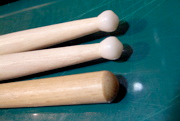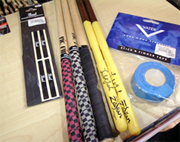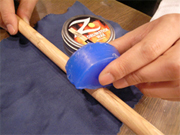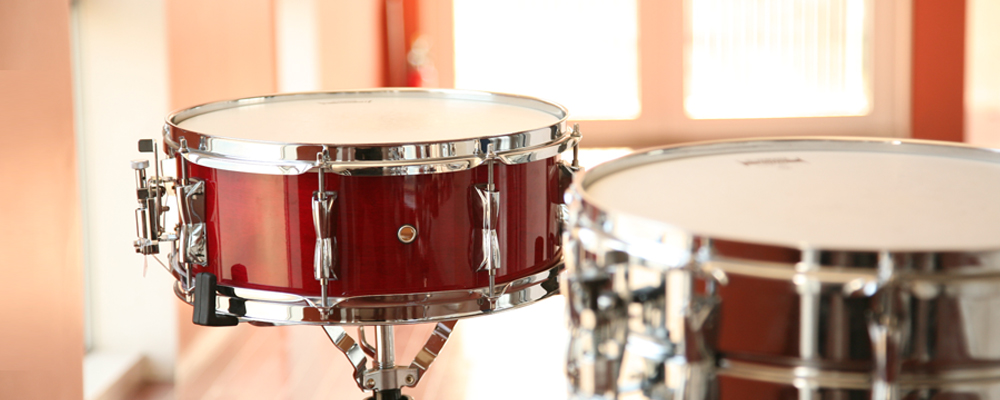Choosing a Drum
Choosing drumsticks
The heavier the better, within limits
To choose the right drumsticks for you, take the thinnest stick and wave it around, then take the fattest and wave it around. Now, try gradually thinner sticks, and take the fattest one that is also easy to wave. This is a good way to choose drumsticks.
The fatter the stick, the heavier and louder it sounds. If you feel that the tone of your current drumsticks lacks punch, try fatter drumsticks. The model number of the standard size drumstick at Yamaha is 7A.
Beginners should start with round-tipped sticks
The tip at the end of the stick is the part that comes into direct contact with the cymbal and so has a major impact on the tone.
There are two broad categories for tips: round tips (photo 1, right) and diamond tips (photo 2, top and center). Round tips strike the drum with the same surface area regardless of the angle of the stick, so the same sound is produced each time. Beginners do not usually have a steady stroke, so a round tip helps to smooth out their sound.
In contrast, with diamond tips, drummers can create different nuances by altering the angle of the stick and thus the surface area of the stick tip that contacts the drum head. For example, striking a cymbal with the tip of the stick produces a slightly lighter tone. Acoustic jazz and similar musical genres demand a more delicate and varied expression, which the diamond-tip drumstick provides.

Photo 1: Ends of the drum stick
Are plastic tips best suited for rock?
In addition to the shape of the tip, the material it is made of also affects the tone.
Recently, there are even tips made of plastic (photo 1, top and center). Plastic is harder than wood, so the attack is stronger, and it produces a harder, cleaner tone. You could even say that it is more suitable for rock music. Sometimes drummers turn the drumsticks around and play with the other end (photo 2, bottom). The larger, heavier portion of the stick strikes the head, making a thicker, bigger sound. Sometimes, they reverse only the stick in the left hand, which plays the snare. Please have a listen.

Photo 2: Ends of the drum stick
Stick grips are useful
The proper way to play the drums is to increase power to the stick at the moment of impact, rather than gripping the stick with a strong grip the entire time. That is why drumsticks often suddenly and unexpectedly fly out of the drummer's hand during a performance. Even professional drummers can be seen losing drumsticks in the middle of a concert. Thus, the best we can do is to try not to lose the drumsticks.

Even with simple grip tape, there are many styles to choose from.
In fact, there are several ingeniously simple tools to help keep drumsticks in your hands where they should be. We discuss two of them below.
The most popular product is grip tape, like that used on the handle of a tennis racket. Grip tape conforms to the shape of your hand immediately, and it only needs to be wrapped around the shaft, so it is very easy to use.
Drumstick wax is another way to prevent slippage. Products such as Zildjian's Drumstick Wax are solid waxes that come in cans and are rubbed onto the shaft of the drumstick. It is very easy to use and very effective.

Zildjian's Drumstick Wax

